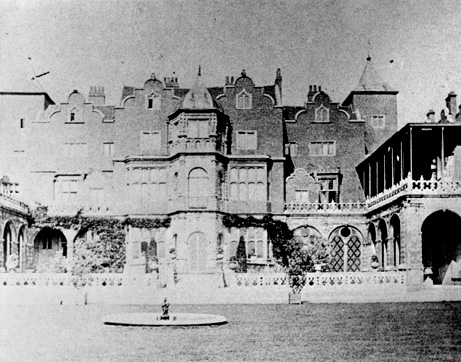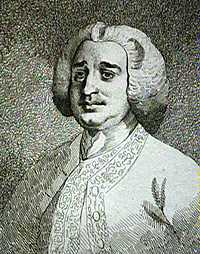Holland Park/Holland House
 Holland House in 1866. |
At the beginning of the seventeeth century Sir Walter Cope, a politician and member of the Elizabethan College of Antiquaries, acquired the village of Kensington and its surrounding pastures, and around 1602 he began to build himself a mansion, "Cope's Castle". A visitor from Switzerland noted the following items in Cope's collection at the house:
holy relics from a a Spanish ship Cope had helped to capture; earthen pitchers and porcelain from China; a Madonna made of feathers, a chain made of monkey teeth, stone shears, a back-scratcher, and a canoe with paddles, all from "India"; a Javanese costume, Arabian coats; the horn and tail of a rhinoceros, the horn of a bull seal, a round horn that had grown on an Englishwoman's forehead, a unicorn's tail; the baubles and bells of Henry VIII's fool, the Turkish emperor's golden seal...The Castle then became the property of Cope's son-in-law, Sir Henry Rich, later the Earl of Holland. Rich made many improvements to the house and grounds, but made the mistake of supporting the Royalists during the Civil War; as a result, he was beheaded by Cromwell, who took Holland House as a headquarters for his generals.
 The first Baron Holland |
Upon the restoration of the monarchy in 1660, the Holland family regained the house, and it was renamed to Holland House. It passed to the Edwardes family in 1721, and was leased in 1746 to Henry Fox, who later became the first Baron Holland. He bought it outright in 1768 and carried out extensive landscape work, planting a number of exotic trees, some of which still survive.
During the life of Fox's grandson, also Henry Richard, the third Baron Holland, the house became a famous social, literary and political centre, and was visited by many famed persons such as Lord Byron, Thomas Macaulay, Benjamin Disraeli, Charles Dickens, Lord Palmerston and Sir Walter Scott. In 1874 the estate was transferred to Henry Edward Fox-Strangways, 5th Earl of Ilchester, a member of the other side of the family - to be precise, the first Baron's nephew's grandson. The house was linked with royalty throughout its entire lifetime, and at various points was visited or stayed in by Queen Mary, King Louis Philippe of France and Queen Victoria; and Queen Elizabeth and King George VI attended the last great ball held there shortly before the Second World War began. Sadly, in September 1940 Holland House was almost completely destroyed by firebombs during a ten-hour raid. Today, as can be seen below, hardly any of the building is left. The remaining wing now houses a youth hostel. During most of the year a canopy is erected in front of the ruins, and the Holland Park Theatre is created, housing the noted Opera Holland Park. |
 The ruins of Holland House today. Photo by Earle. |